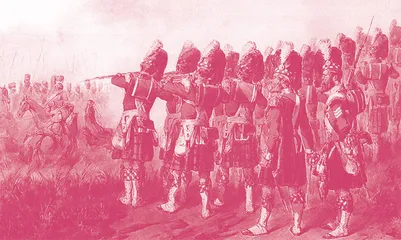The Thin Red Line细细的红线
作者: 约翰·辛普森 田兵译

In the days before the Internet, I came to see that one of the characteristics that really distinguished OED entries was the quality of the historical research that went into their compilation. Later, we had help from all manner of digital resources to discover earlier references to the words or phrases we were working on. Back then, it was just the researcher against a shelf full of books and library catalogues, and no one gave you any hints about where to start looking. A classic example of this is illustrated by the work we conducted to research the history of the expression the thin red line.
在互联网时代到来之前,我已逐渐明白,真正使《牛津英语词典》卓尔不群的一个特征,是它将高品质的历史研究带进了词典编纂。之后,我们拥有了各种形式的数字资源,帮助我们针对词典所收的单词和短语寻找更早的参考文献。当年,只有研究者单枪匹马,面对满满一架子的书和资料馆藏书目录,也没有谁给出任何提示,该从哪里开始寻找。这方面的一个经典案例,是针对the thin red line这一表达的历史所做的检索,很能够说明我们当时的工作状况。
The thin red line was an expression that the original OED compilers had utterly forgotten to include. Arguably, this was rather casual of them. The expression was well established when they reached red, and even if it hadn’t been, there would have been another chance to include it several years later when they reached thin. I presume1 they thought that, since it consisted of three words, it was more of a phrase than a word, and so its natural right of entry into the dictionary was compromised. We had to be practical: two-word compounds could easily be included if they had gained a firm foothold in the language; three-word compounds were more questionable, and it was sometimes hard to determine whether they were fixed expressions or chance collocations of the three elements; four-word compounds were even less likely to be included.
the thin red line这一表达,第一版《牛津英语词典》的编纂者竟完全忘记收录。可以说,他们有些大意了。当编辑工作进行到red时,该表达已经众所周知,即便当时没有收录,几年后编纂至thin时,他们也还是有机会将它补录进来的。我推测他们可能是这么认为的:既然这一表达由三个实词组成,那么它就应是一个短语而非单词,因而作为独立条目收入词典的天然“合法性”就被破坏了。我们不得不实际一些:双词组成的合成词,一旦在语言中立稳脚跟,很容易被收录;三词组成的合成词,更容易受到质疑,有时难以确定它们到底是固定表达,还是三个组分的随机搭配;四词组成的合成词,被收录的可能性就更小了。
By the late 1970s, when we were working on red for the Supplement to the OED, we concluded that thin red line was admissible. Almost all of the work on red had been edited by my old trainer, Lesley, and she was not one to leave any stone unturned. Her bundle2 of red words included thin red line. Everyone knew, in those days, that this was a historical expression that referred to the British Army in line of battle, in its role as protector—thin and stretched out in its redcoat uniform trying desperately to save the British Empire from the forces of darkness. The more of these forces that came along, the thinner the line became.
到1970年代末,《牛津英语词典·补编》在修订red词条时,我们一致认为:可以收录thin red line。red一词的所有编辑工作几乎都是由我原先的培训导师莱斯莉一手完成的,她在工作中向来干净彻底、不留死角。她编辑的那组red词语中包括了thin red line。在当时,尽人皆知,这是一个有历史含义的表达,指英军排成作战队形、起到保护作用:他们阵列稀疏,横向伸展,士兵们身穿红色制服,为保卫大英帝国而与黑暗力量殊死较量。这些黑暗势力来得越多,那条英军阵列就变得愈加稀疏单薄。
Suggestions in our card file indicated that the phrase was redolent3 of the Battle of Balaclava, in the Crimean War. But Lesley had a serious problem here. She had an armful of documentary evidence for thin red line collected over a hundred years or so by the dictionary’s “readers,” but none of this predated 1935 and a jingoistic4 occurrence in a novel by George Orwell. The Battle of Balaclava took place on 25 October 1854. So either the expression thin red line had nothing to do with the battle, or our documentary evidence started almost a hundred years too late.
我们卡片文档中记载的种种信息显示,这一短语可关联到克里米亚战争中的巴拉克拉瓦战役。但是,莱斯莉在此碰到一个严重问题。对于thin red line,她有大量文献证据,是大约100年里《牛津英语词典》的“读者”所收集的,但没有一则早于1935年,还有一则表达沙文主义含义的出现在乔治·奥威尔的一部小说中。巴拉克拉瓦战役发生在1854年10月25日。所以,要么thin red line这一表达与那场战役毫无瓜葛,要么我们的文献证据开始收集的时间晚了将近100年。
For the everyday dictionary editor, there were precious few resources on the Crimean War in the language-flavoured OED library. But all was not lost. In researching the expression in the dictionary’s reference library, Lesley had followed protocol5 and inspected quotations dictionaries, just on the off-chance6. As well as the standard Oxford Dictionary of Quotations, we also checked through various editions of John Bartlett’s Familiar Quotations, published in America since the mid-nineteenth century and a powerhouse of recondite information on sayings familiar and less so. My personal favourite in this corner of the library was Burton Stevenson’s Home Book of Quotations, a massive red brick of a book published posthumously in New York in 1967, and amalgamating much of Stevenson’s early work on phrases.
对于日常的词典编辑人员来讲,在语言气息浓厚的《牛津英语词典》资料馆里,关于克里米亚战争的资料极少,但也并非是遗失殆尽。在词典部工具书资料馆中检索该表达时,莱斯莉遵守规程,核检了那些引语词典,只是想碰碰运气。除标准的《牛津引语词典》,我们还一一核查了约翰·巴特利特《常见引语》的不同版本——该词典19世纪中期在美国出版后连续再版,是一个包含鲜见信息的资源库,收录了大量人们熟悉和不熟悉的格言警句。在资料馆的这一角落,我个人最喜欢伯顿·史蒂文森的《家庭引语集》,一部红砖般的大部头词典,是他去世后于1967年在纽约出版的,算是他早期大部分短语著述的集成之作。
But this time it was John Bartlett who nearly came up trumps, with a reference to The Times report of 25 October 1854 on the Battle of Balaclava, which provided a reference to the “thin red streak tipped with a line of steel7” at the battle, and attributed the reference to the paper’s Irish war correspondent (later Sir) William Howard Russell (1820–1907). Problem No. 1: this wasn’t actually the expression we were looking for. It was close, but not close enough.